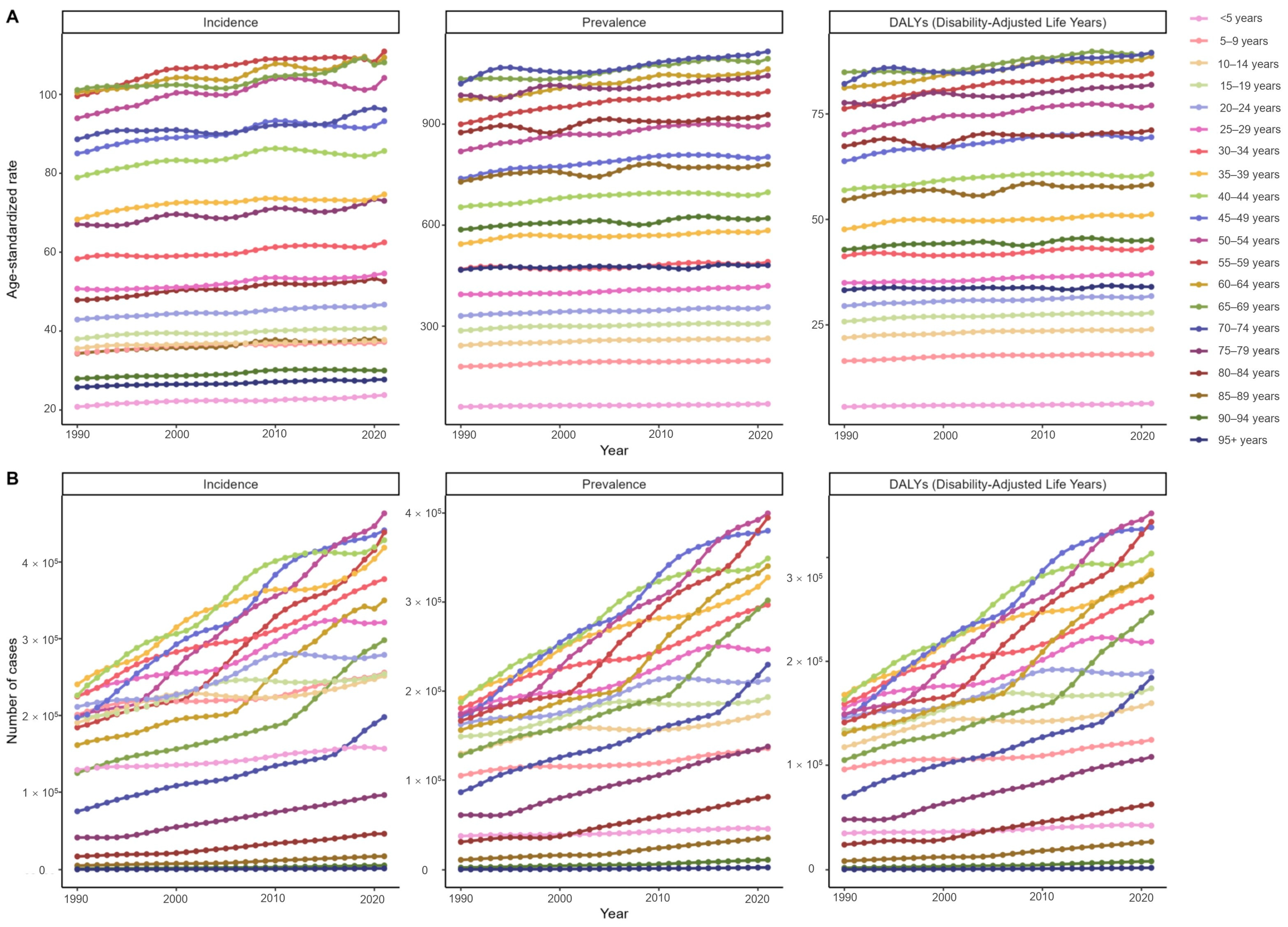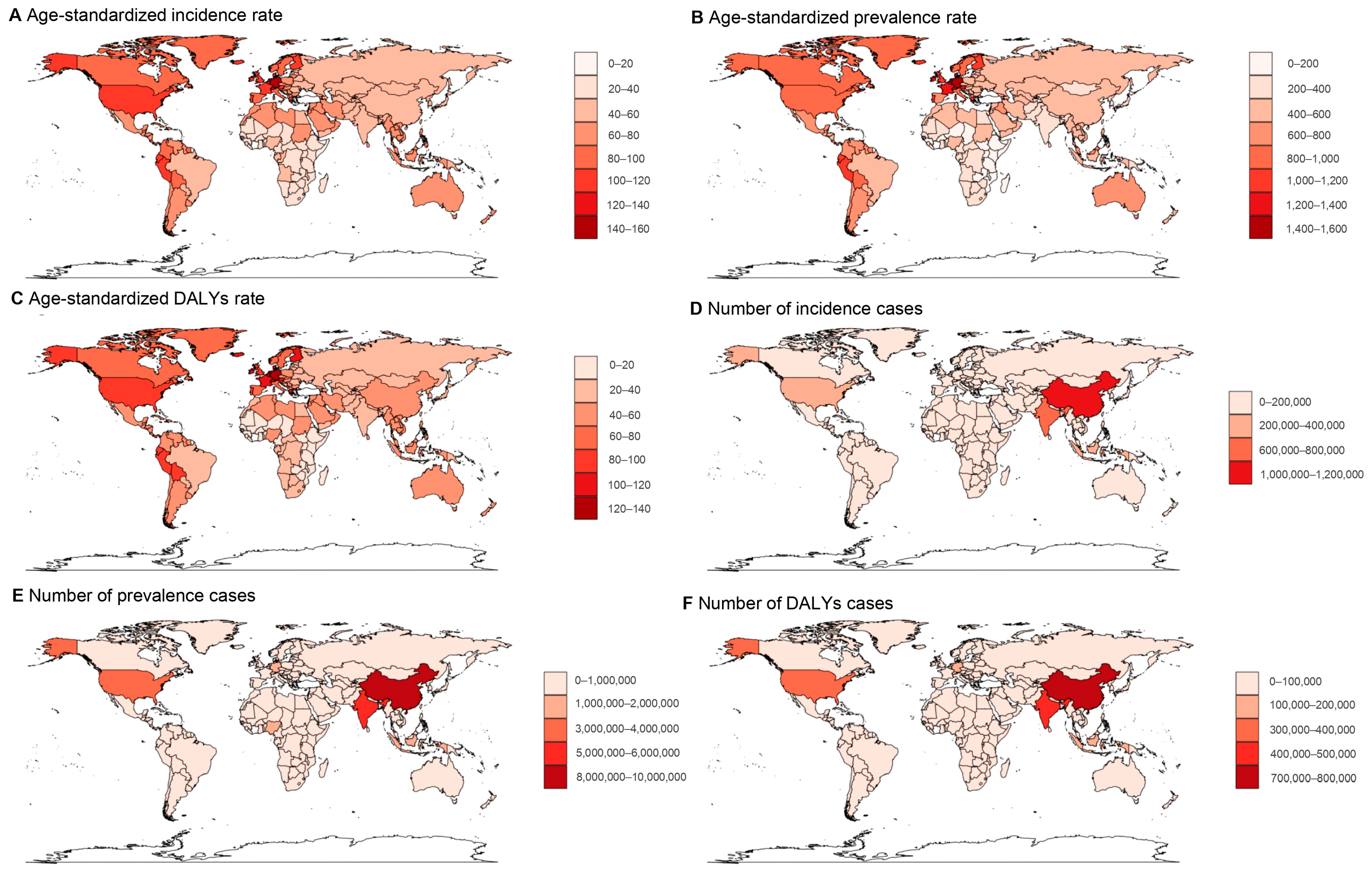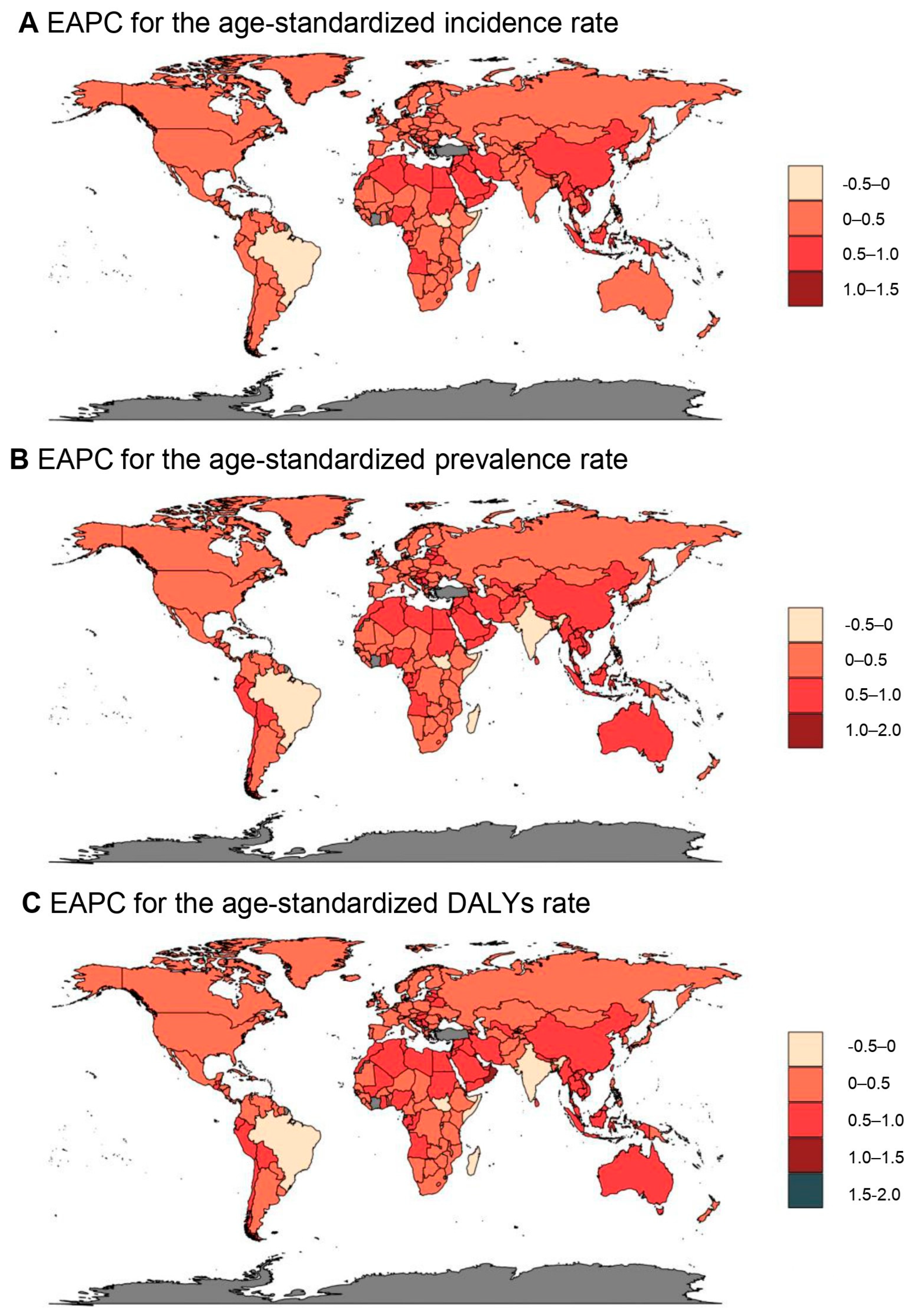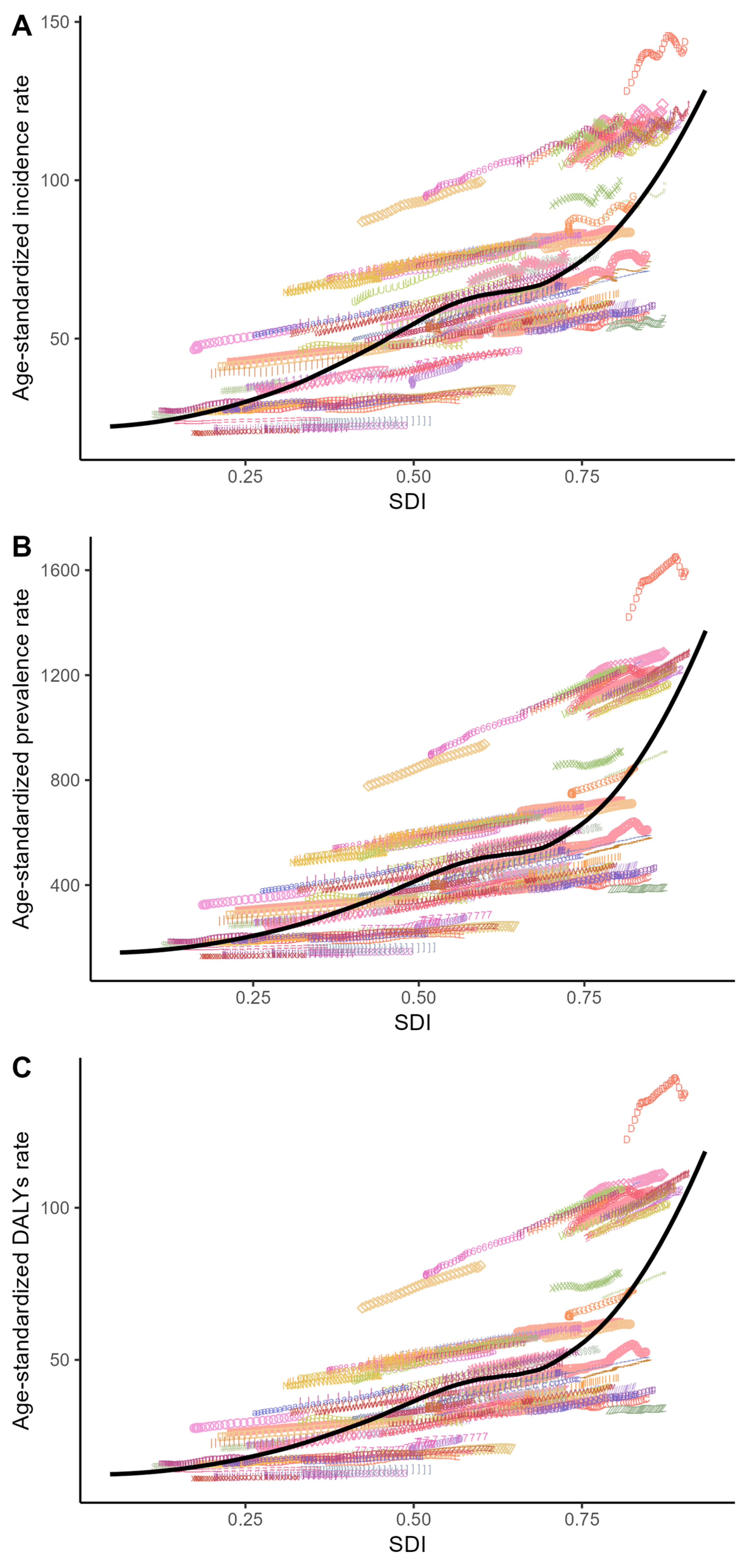Global Psoriasis Burden 1990–2021: Evolving Patterns and Socio-Demographic Correlates in the Global Burden of Disease 2021 Update
Abstract
1. Introduction
2. Methods
2.1. Overview
2.2. Study Data
2.3. Statistical Analyses
3. Results
3.1. Global Burden Attributable to Psoriasis by Age and Sex
3.2. Burden of Psoriasis at Regional Level
3.3. Burden of Psoriasis on National Level
3.4. Global Burden of Psoriasis by Socio-Demographic Index
3.5. The Correlation Between SDI and Psoriasis’ Incidence, Prevalence, and DALYs
4. Discussion
5. Conclusions
Supplementary Materials
Author Contributions
Funding
Institutional Review Board Statement
Informed Consent Statement
Data Availability Statement
Acknowledgments
Conflicts of Interest
Abbreviations
| GBD | Global Burden of Diseases |
| DALYs | Disability-Adjusted Life Years |
| ASR | Age-Standardized Rate |
| ASIR | Age-Standardized Incidence Rate |
| ASPR | Age-Standardized Prevalence Rate |
| ASDR | Age-Standardized DALY Rate |
| SDI | Socio-demographic Index |
| EAPC | Estimated Annual Percentage Change |
| CI | Confidence Interval |
| UI | Uncertainty Interval |
| HDI | Human Development Index |
| IHME | Institute for Health Metrics and Evaluation |
| AD | Atopic Dermatitis |
| GHDx | Global Health Data Exchange |
References
- Golińska, J.; Sar-Pomian, M.; Rudnicka, L. Dermoscopic features of psoriasis of the skin, scalp and nails—A systematic review. J. Eur. Acad. Dermatol. Venereol. 2019, 33, 648–660. [Google Scholar] [CrossRef] [PubMed]
- Alinaghi, F.; Calov, M.; Kristensen, L.E.; Gladman, D.D.; Coates, L.C.; Jullien, D.; Gottlieb, A.B.; Gisondi, P.; Wu, J.J.; Thyssen, J.P.; et al. Prevalence of psoriatic arthritis in patients with psoriasis: A systematic review and meta-analysis of observational and clinical studies. J. Am. Acad. Dermatol. 2019, 80, 251–265.e19. [Google Scholar] [CrossRef] [PubMed]
- Tang, X.; Chen, L. The risk of organ-based comorbidities in psoriasis: A systematic review and meta-analysis. Bras. Dermatol. 2022, 97, 612–623. [Google Scholar] [CrossRef] [PubMed]
- Saleem, M.D.; Kesty, C.; Feldman, S.R. Relative versus absolute risk of comorbidities in patients with psoriasis. J. Am. Acad. Dermatol. 2017, 76, 531–537. [Google Scholar] [CrossRef]
- Griffiths, C.E.M.; Armstrong, A.W.; Gudjonsson, J.E.; Barker, J. Psoriasis. Lancet 2021, 397, 1301–1315. [Google Scholar] [CrossRef]
- Kang, Z.; Zhang, X.; Du, Y.; Dai, S.-M. Global and regional epidemiology of psoriatic arthritis in patients with psoriasis: A comprehensive systematic analysis and modelling study. J. Autoimmun. 2024, 145, 103202. [Google Scholar] [CrossRef] [PubMed]
- Pollo, C.F.; Miot, H.A.; Matos, T.D.d.S.; de Souza, J.M.; Jorge, M.F.S.; Miot, L.D.B.; Meneguin, S. Prevalence and factors associated with depression and anxiety in patients with psoriasis. J. Clin. Nurs. 2021, 30, 572–580. [Google Scholar] [CrossRef]
- Parisi, R.; Webb, R.; Kleyn, C.; Carr, M.; Kapur, N.; Griffiths, C.; Ashcroft, D. Psychiatric morbidity and suicidal behaviour in psoriasis: A primary care cohort study. Br. J. Dermatol. 2019, 180, 108–115. [Google Scholar] [CrossRef]
- Bakar, R.S.; Jaapar, S.Z.; Azmi, A.F.; Aun, Y.C. Depression and anxiety among patients with psoriasis: A correlation with quality of life and associated factors. J. Taibah Univ. Med. Sci. 2021, 16, 491–496. [Google Scholar] [CrossRef]
- Adesanya, E.I.; Matthewman, J.; Schonmann, Y.; Hayes, J.F.; Henderson, A.; Mathur, R.; Mulick, A.R.; Smith, C.H.; Langan, S.M.; Mansfield, K.E. Factors associated with depression, anxiety and severe mental illness among adults with atopic eczema or psoriasis: A systematic review and meta-analysis. Br. J. Dermatol. 2023, 188, 460–470. [Google Scholar] [CrossRef]
- Singh, S.; Taylor, C.; Kornmehl, H.; Armstrong, A.W. Psoriasis and suicidality: A systematic review and meta-analysis. J. Am. Acad. Dermatol. 2017, 77, 425–440.e2. [Google Scholar] [CrossRef] [PubMed]
- Xie, W.; Huang, H.; Deng, X.; Gao, D.; Zhang, Z. Modifiable lifestyle and environmental factors associated with onset of psoriatic arthritis in patients with psoriasis: A systematic review and meta-analysis of observational studies. J. Am. Acad. Dermatol. 2021, 84, 701–711. [Google Scholar] [CrossRef]
- Wu, Q.; Xu, Z.; Dan, Y.L.; Zhao, C.N.; Mao, Y.M.; Liu, L.N.; Pan, H.F. Seasonality and global public interest in psoriasis: An infodemiology study. Postgrad. Med. J. 2020, 96, 139–143. [Google Scholar] [CrossRef]
- Parisi, R.; Iskandar, I.Y.K.; Kontopantelis, E.; Augustin, M.; Griffiths, C.E.M.; Ashcroft, D.M. National, regional, and worldwide epidemiology of psoriasis: Systematic analysis and modelling study. BMJ 2020, 369, m1590. [Google Scholar] [CrossRef] [PubMed]
- Aalemi, A.K.; Dimmock, P.; Parisi, R.; Kontopantelis, E.; Griffiths, C.; Ashcroft, D. Global epidemiology of psoriasis: Global Psoriasis Atlas 2024 update. Br. J. Dermatol. 2024, 191 (Suppl. 3), ljae360.061. [Google Scholar] [CrossRef]
- Rudd, K.E.; Johnson, S.C.; Agesa, K.M.; Shackelford, K.A.; Tsoi, D.; Kievlan, D.R.; Colombara, D.V.; Ikuta, K.S.; Kissoon, N.; Finfer, S.; et al. Global, regional, and national sepsis incidence and mortality, 1990-2017: Analysis for the Global Burden of Disease Study. Lancet 2020, 395, 200–211. [Google Scholar] [CrossRef]
- GBD 2019 Diseases and Injuries Collaborators. Global burden of 369 diseases and injuries in 204 countries and territories, 1990–2019: A systematic analysis for the Global Burden of Disease Study 2019. Lancet 2020, 396, 1204–1222. [Google Scholar] [CrossRef]
- Murray, C.J.L. The Global Burden of Disease Study at 30 years. Nat. Med. 2022, 28, 2019–2026. [Google Scholar] [CrossRef]
- Ong, K.L.; Stafford, L.K.; McLaughlin, S.A.; Boyko, E.J.; Vollset, S.E.; Smith, A.E.; Dalton, B.E.; Duprey, J.; Cruz, J.A.; Hagins, H.; et al. Global, regional, and national burden of diabetes from 1990 to 2021, with projections of prevalence to 2050: A systematic analysis for the Global Burden of Disease Study 2021. Lancet 2023, 402, 203–234. [Google Scholar] [CrossRef]
- Gardner, W.M.; Razo, C.; McHugh, T.A.; Hagins, H.; Vilchis-Tella, V.M.; Hennessy, C.; Taylor, H.J.; Perumal, N.; Fuller, K.; Cercy, K.M.; et al. Prevalence, years lived with disability, and trends in anaemia burden by severity and cause, 1990-2021: Findings from the Global Burden of Disease Study 2021. Lancet Haematol. 2023, 10, e713–e734. [Google Scholar] [CrossRef]
- Stevens, G.A.; Alkema, L.; Black, R.E.; Boerma, J.T.; Collins, G.S.; Ezzati, M.; Grove, J.T.; Hogan, D.R.; Hogan, M.C.; Horton, R.; et al. Guidelines for Accurate and Transparent Health Estimates Reporting: The GATHER statement. Lancet 2016, 388, e19–e23. [Google Scholar] [CrossRef]
- Zhu, J.; Cui, Y.; Zhang, J.; Yan, R.; Su, D.; Zhao, D.; Wang, A.; Feng, T. Temporal trends in the prevalence of Parkinson’s disease from 1980 to 2023: A systematic review and meta-analysis. Lancet Healthy Longev. 2024, 5, e464–e479. [Google Scholar] [CrossRef]
- Zhang, W.; Zeng, W.; Jiang, A.; He, Z.; Shen, X.; Dong, X.; Feng, J.; Lu, H. Global, regional and national incidence, mortality and disability-adjusted life-years of skin cancers and trend analysis from 1990 to 2019: An analysis of the Global Burden of Disease Study 2019. Cancer Med. 2021, 10, 4905–4922. [Google Scholar] [CrossRef]
- Zhao, Y.; Sullivan, E.; Son, M.B.; Beukelman, T. Psoriasis rate is increased by the exposure to TNF inhibition in children with JIA. Ann. Rheum. Dis. 2022, 81, 662–665. [Google Scholar] [CrossRef] [PubMed]
- Coates, L.C.; Soriano, E.R.; Corp, N.; Bertheussen, H.; Duffin, K.C.; Campanholo, C.B.; Chau, J.; Eder, L.; Fernández-Ávila, D.G.; Garg, A.; et al. Group for Research and Assessment of Psoriasis and Psoriatic Arthritis (GRAPPA): Updated treatment recommendations for psoriatic arthritis 2021. Nat. Rev. Rheumatol. 2022, 18, 465–479. [Google Scholar] [CrossRef]
- Liu, S.; He, M.; Jiang, J.; Duan, X.; Chai, B.; Zhang, J.; Tao, Q.; Chen, H. Triggers for the onset and recurrence of psoriasis: A review and update. Cell Commun. Signal. 2024, 22, 108. [Google Scholar] [CrossRef] [PubMed]
- Murer, C.; Sgier, D.; Mettler, S.K.; Guillet, C.; Maul, J.-T.; Djamei, V.; Navarini, A.A.; Anzengruber, F. Gender differences in psoriasis: A Swiss online psoriasis survey. Arch. Dermatol. Res. 2021, 313, 89–94. [Google Scholar] [CrossRef]
- Tarannum, S.; Leung, Y.-Y.; Johnson, S.R.; Widdifield, J.; Strand, V.; Rochon, P.; Eder, L. Sex- and gender-related differences in psoriatic arthritis. Nat. Rev. Rheumatol. 2022, 18, 513–526. [Google Scholar] [CrossRef]
- Rao, M.; Chen, S.-Y.; Liang, Y.; Yu, J. Underdiagnosis of psoriasis in underrepresented groups: An “All of Us” database analysis. J. Am. Acad. Dermatol. 2023, 89, 1279–1282. [Google Scholar] [CrossRef]
- Kaufman, B.P.; Alexis, A.F. Psoriasis in Skin of Color: Insights into the Epidemiology, Clinical Presentation, Genetics, Quality-of-Life Impact, and Treatment of Psoriasis in Non-White Racial/Ethnic Groups. Am. J. Clin. Dermatol. 2018, 19, 405–423. [Google Scholar] [CrossRef]
- Chandran, V.; Raychaudhuri, S.P. Geoepidemiology and environmental factors of psoriasis and psoriatic arthritis. J. Autoimmun. 2010, 34, J314–J321. [Google Scholar] [CrossRef] [PubMed]
- Ferguson, J.E.; Seger, E.W.; White, J.; McMichael, A. Racial/ethnic differences in treatment efficacy and safety for moderate-to-severe plaque psoriasis: A systematic review. Arch. Dermatol. Res. 2023, 315, 41–50. [Google Scholar] [CrossRef] [PubMed]
- Ricardo, J.W.; Qiu, Y.; Lipner, S.R. Racial, Ethnic, and Sex Disparities in Nail Psoriasis Clinical Trials: A Systematic Review. Ski. Appendage Disord. 2022, 8, 171–178. [Google Scholar] [CrossRef]
- Oh, J.; Kim, S.; Kim, M.S.; Abate, Y.H.; ElHafeez, S.A.; Abdelkader, A.; Abdi, P.; Abdulah, D.M.; Aboagye, R.G.; Abolhassani, H.; et al. Global, regional, and national burden of asthma and atopic dermatitis, 1990-2021, and projections to 2050: A systematic analysis of the Global Burden of Disease Study 2021. Lancet Respir. Med. 2025, 13, 425–446. [Google Scholar] [CrossRef]
- Tan, S.; Tang, H.; Li, G.; Zhao, J.; Xin, X.; Wang, S.; Wu, D. Global, Regional, and National Burden of Dermatitis from 1990 to 2021, and Forecasts to 2050: A Systematic Analysis of the Global Burden of Disease Study 2021. Dermat. Contact Atopic Occup. Drug 2025. [Google Scholar] [CrossRef]
- Li, D.; Chen, M.; Li, W.; Xu, X.; Li, Q. Global burden of viral skin diseases from 1990 to 2021: A systematic analysis for the global burden of disease study 2021. Front. Public Health 2025, 13, 1464372. [Google Scholar] [CrossRef]
- Ding, H.; Yu, Z.; Yao, H.; Xu, X.; Liu, Y.; Chen, M. Global burden of alopecia areata from 1990 to 2019 and emerging treatment trends analyzed through GBD 2019 and bibliometric data. Sci. Rep. 2025, 15, 25869. [Google Scholar] [CrossRef] [PubMed]
- Damiani, G.; Bragazzi, N.L.; Aksut, C.K.; Wu, D.; Alicandro, G.; McGonagle, D.; Guo, C.; Dellavalle, R.; Grada, A.; Wong, P.; et al. The Global, Regional, and National Burden of Psoriasis: Results and Insights From the Global Burden of Disease 2019 Study. Front. Med. 2021, 8, 743180. [Google Scholar] [CrossRef] [PubMed]
- Gondo, G.; Kumar, I.; Eakin, G.; Merola, J.; Gottlieb, A. 51670 Undertreatment among patients with psoriasis in the United States: Results from the 2022 National Psoriasis Foundation Annual Survey. J. Am. Acad. Dermatol. 2024, 91, AB350. [Google Scholar] [CrossRef]
- Hernández-Vásquez, A.; Molinari, L.; Larrea, N.; Ciapponi, A. Psoriasis in Latin America and the Caribbean: A systematic review. J. Eur. Acad. Dermatol. Venereol. 2017, 31, 1991–1998. [Google Scholar] [CrossRef]
- Charrow, A.; Di Xia, F.; Joyce, C.; Mostaghimi, A. Diversity in Dermatology Clinical Trials: A Systematic Review. JAMA Dermatol. 2017, 153, 193–198. [Google Scholar] [CrossRef] [PubMed]
- Korman, N.J. Management of psoriasis as a systemic disease: What is the evidence? Br. J. Dermatol. 2020, 182, 840–848. [Google Scholar] [CrossRef] [PubMed]






| 1990 | 2021 | 1990–2021 | |||
|---|---|---|---|---|---|
| Characteristics | Numbers × 103 (95% UI) | ASR | Numbers × 103 (95% UI) | ASR | EAPC |
| No. × 10−5 (95%UI) | No. × 10−5 (95%UI) | (95% CI) | |||
| Global | 1996.8 (1441.3–2670.8) | 41.1 (29.8–54.9) | 3689.9 (2684–4917.1) | 44.4 (32.2–59.2) | 0.23 (0.21–0.25) |
| Female | 1006.7 (726.8–1342.1) | 40.8 (29.5–54.4) | 1812.5 (1320.4–2412.1) | 43.4 (31.6–57.8) | 0.18 (0.17–0.20) |
| Male | 990.0 (714.7–1328.7) | 41.4 (30–55.6) | 1877.4 (1363.7–2506.6) | 45.4 (33–60.6) | 0.28 (0.26–0.30) |
| SDI | |||||
| High SDI | 658.6 (477.5–882) | 68.3 (49.4–91.4) | 975.4 (714.2–1297.6) | 73.3 (53.2–97.7) | 0.18 (0.16–0.21) |
| High–middle SDI | 418.7 (302–561.3) | 39.1 (28.2–52.3) | 750.4 (546.3–999.4) | 47.6 (34.5–63.3) | 0.65 (0.63–0.67) |
| Middle SDI | 546.0 (393.2–729.7) | 35.9 (25.9–47.9) | 1144.2 (829.6–1527.3) | 43.2 (31.3–57.6) | 0.59 (0.57–0.61) |
| Low–middle SDI | 286.0 (206.3–382.9) | 28.9 (20.8–38.7) | 599.9 (432.7–806.8) | 32.5 (23.5–43.6) | 0.30 (0.27–0.32) |
| Low SDI | 85.3 (61.7–115.1) | 21.2 (15.2–28.3) | 216.7 (157.3–292.2) | 23.1 (16.7–30.9) | 0.26 (0.22–0.30) |
| GBD Regions | |||||
| High-income Asia Pacific | 62.5 (45.5–83.7) | 32.7 (23.7–43.8) | 82.2 (59.7–109.3) | 34.6 (24.9–46.2) | 0.14 (0.13–0.16) |
| Central Asia | 19.6 (14.1–26) | 32.0 (23–42.5) | 34.4 (24.9–45.8) | 35.8 (25.9–47.8) | 0.40 (0.38–0.43) |
| East Asia | 351.1 (253–471.6) | 31.0 (22.4–41.5) | 742.9 (539.1–990.5) | 40.6 (29.4–54.3) | 0.89 (0.84–0.93) |
| South Asia | 272.8 (197–366.6) | 28.5 (20.6–38.2) | 570.5 (410.8–765.5) | 31.0 (22.4–41.7) | 0.08 (0.03–0.13) |
| Southeast Asia | 152.5 (109.9–204.8) | 39.0 (28.2–52.2) | 342.9 (249.7–459.2) | 47.2 (34.3–63.2) | 0.62 (0.60–0.63) |
| Australasia | 9.8 (7.1–13) | 45.3 (32.6–60.6) | 18.8 (13.4–24.9) | 52.1 (37.3–69.6) | 0.56 (0.49–0.62) |
| Caribbean | 16.6 (12–22.2) | 51.2 (36.9–68.5) | 26.8 (19.2–35.7) | 53.7 (38.4–71.8) | 0.18 (0.17–0.19) |
| Central Europe | 48.9 (35.5–64.8) | 35.9 (26.0–47.5) | 58.9 (43–78.1) | 41.4 (30.0–55.2) | 0.49 (0.47–0.51) |
| Eastern Europe | 83.1 (60.3–110.7) | 33.4 (24.3–44.5) | 95.2 (69.6–127.1) | 37.9 (27.5–50.5) | 0.45 (0.43–0.48) |
| Western Europe | 396.7 (286.4–531.5) | 90 (64.8–120.1) | 541.5 (393.9–723.9) | 99.8 (72.2–133.9) | 0.26 (0.22–0.30) |
| Andean Latin America | 24.4 (17.7–33) | 74.5 (54.0–100.6) | 58.2 (42.2–77.6) | 88.4 (64.1–117.7) | 0.59 (0.55–0.62) |
| Central Latin America | 70.8 (50.8–94.6) | 50.5 (36.4–66.8) | 144.9 (104.6–193.6) | 55.6 (40.1–74.3) | 0.32 (0.31–0.32) |
| Southern Latin America | 22.5 (16.3–30) | 46.3 (33.6–61.7) | 39.0 (28.4–52.1) | 52.6 (38.3–70.5) | 0.38 (0.37–0.39) |
| Tropical Latin America | 49.2 (35.4–65.8) | 35.5 (25.6–47.6) | 85.3 (61.9–113.2) | 35.2 (25.5–46.8) | 0.04 (0.03–0.06) |
| North Africa and Middle East | 94.0 (67.6–126.8) | 34.5 (25.0–46.1) | 265.4 (189.4–355) | 43.6 (31.2–58.3) | 0.81 (0.79–0.83) |
| High-income North America | 241.4 (175.2–323.1) | 80.4 (58.1–107.4) | 362.2 (265.4–476.6) | 83.1 (60.4–109.7) | 0.12 (0.10–0.14) |
| Oceania | 1.5 (1.1–2) | 29.2 (21.0–38.4) | 3.9 (2.8–5.2) | 32.9 (23.6–43.6) | 0.36 (0.35–0.38) |
| Central Sub-Saharan Africa | 9.9 (7.1–13.3) | 22.4 (16.1–29.7) | 29.7 (21.6–40) | 26.0 (18.8–34.9) | 0.51 (0.42–0.59) |
| Eastern Sub-Saharan Africa | 18.7 (13.5–25.2) | 12.6 (9.1–16.9) | 45.3 (33–60.8) | 13.0 (9.5–17.3) | 0.14 (0.12–0.15) |
| Southern Sub-Saharan Africa | 8.9 (6.4–11.8) | 19.8 (14.3–26.3) | 16.1 (11.6–21.6) | 20.8 (14.9–27.8) | 0.23 (0.20–0.26) |
| Western Sub-Saharan Africa | 41.8 (30.4–56.5) | 27.1 (19.7–36.3) | 125.8 (91.6–169.1) | 31.6 (22.9–42.2) | 0.61 (0.56–0.66) |
Disclaimer/Publisher’s Note: The statements, opinions and data contained in all publications are solely those of the individual author(s) and contributor(s) and not of MDPI and/or the editor(s). MDPI and/or the editor(s) disclaim responsibility for any injury to people or property resulting from any ideas, methods, instructions or products referred to in the content. |
© 2025 by the authors. Licensee MDPI, Basel, Switzerland. This article is an open access article distributed under the terms and conditions of the Creative Commons Attribution (CC BY) license (https://creativecommons.org/licenses/by/4.0/).
Share and Cite
Li, D.; Fan, S.; Song, J.; Zhao, H.; Guo, L.; Li, P.; Xu, X. Global Psoriasis Burden 1990–2021: Evolving Patterns and Socio-Demographic Correlates in the Global Burden of Disease 2021 Update. Healthcare 2025, 13, 2437. https://doi.org/10.3390/healthcare13192437
Li D, Fan S, Song J, Zhao H, Guo L, Li P, Xu X. Global Psoriasis Burden 1990–2021: Evolving Patterns and Socio-Demographic Correlates in the Global Burden of Disease 2021 Update. Healthcare. 2025; 13(19):2437. https://doi.org/10.3390/healthcare13192437
Chicago/Turabian StyleLi, Deng, Siqi Fan, Jiayi Song, Haochen Zhao, Linfen Guo, Peiyu Li, and Xuewen Xu. 2025. "Global Psoriasis Burden 1990–2021: Evolving Patterns and Socio-Demographic Correlates in the Global Burden of Disease 2021 Update" Healthcare 13, no. 19: 2437. https://doi.org/10.3390/healthcare13192437
APA StyleLi, D., Fan, S., Song, J., Zhao, H., Guo, L., Li, P., & Xu, X. (2025). Global Psoriasis Burden 1990–2021: Evolving Patterns and Socio-Demographic Correlates in the Global Burden of Disease 2021 Update. Healthcare, 13(19), 2437. https://doi.org/10.3390/healthcare13192437






